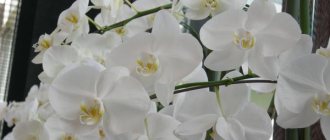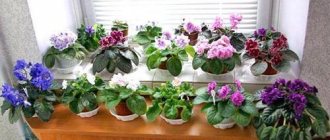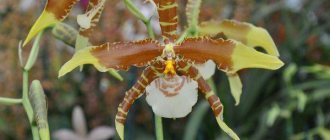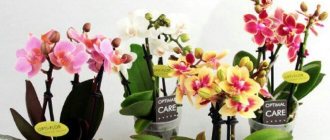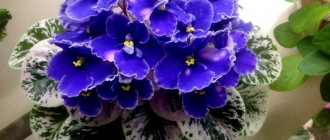Hybrid phalaenopsis
Phalaenopsis belongs to the orchid family. This type of orchid was first discovered in 1825 on the islands of the Malay archipelago. After that, these unusual plants of different species were found in the territory of Southeast Indonesia and the tropical region of Australia. They gave rise to many hybrids and varieties of phalaenopsis.
Standard
The first phalaenopsis hybrids had large white or pink flowers and tall peduncles. They are called standard. Further interspecific selection continued in various directions:
- breeding plants with large flowers;
- brightly colored or variegated petals;
- miniature phalaenopsis, etc.
Example of hybrid Maki Watanabe 'Kingfisher Orchids' (Romance Miki X Otohime)
Mini
In the middle of the last century, miniature phalaenopsis came into fashion. This is a fairly large group of varieties that share common characteristics:
- small flower-bearing arrow;
- small classically shaped flowers.
Phalaenopsis mini. Size relative to lighter size.
Taiwanese
Nowadays, Singapore is a trendsetter in the field of orchid breeding, resulting in plants with pure petals of bright colors or spotted patterns , for which they were called “harlequins”.
Taiwanese Phalaenopsis Harlequin.
Novelty
These hybrids include plants with non-dying peduncles . After flowering, they enter a dormant period, after which old flower stalks simultaneously grow and new ones form.
An adult novelty can have several dozen inflorescences that bloom up to 5 times a year. The petals of small flowers are covered with a tiger or leopard pattern, ripples or dots of different sizes.
Novelty I-Hsin Salmon Copper Star.
Pelorics
Phalaenopsis pelorica is of particular interest to orchid collectors. Peloric is a plant that has undergone a mutation, as a result of which its flowers have an atypical shape for its variety, and the petals and sepals take on the shape of a flower lip , which gives the flower an unusual appearance.
Philadelphia Peloric.
Primary
The selection of numerous varieties and hybrids of phalaenopsis began with interspecific hybridization:
- The first Phalaenopsis hybrid was obtained in 1875 by John Seden as a result of the hybridization of Phal. aphrodite and Phal. equestris. And by 1900 there were already thirteen such hybrids;
- an unusual hybrid was obtained in 1940 and registered under the name Phal.Doris. It is characterized by multi-flowered peduncles and huge, pure white flowers of a flattened shape, about 14 cm in diameter;
- A striking representative of miniature hybrid phalaenopsis is Phal. Mini Mark "Maria Teresa" , reaching a height of 25 cm. A large number of branched peduncles are strewn with small flowers with an ivory color , dotted with tiny red-yellow spots;
- spotted hybrid phalaenopsis is represented by phalaenopsis of French selection and Taiwanese “harlequins”. One of the common varieties is Phal. "Paradise" , an exquisite variety with medium-sized flowers and elongated petals of a light greenish-yellow hue, dotted with pink-brown specks.
Phalaenopsis Krabi Paradise.
Interesting! Currently, more than 5 thousand phalaenopsis hybrids have been registered.
Intergeneric
A further impetus for obtaining new forms and colors of phalaenopsis was their hybridization with related genera of orchids:
- Doritis;
- Renanthera;
- Ascocentrum;
- Rhynchostylis et al.
The first intergeneric hybrid called Doritaenopsis with an unusual scarlet color of flowers was obtained in 1923 as a result of crossing a phalaenopsis with an orchid of the genus Doritis. Further selection led to the creation of flowers of other, more complex shades: purple, orange, etc.
Often these orchids are confused, selling one variety after another. But both their appearance and the conditions of their maintenance are identical.
Doritaenopsis Liu's Sakura caused particular delight . Its exquisitely shaped flowers with pinkish pearlescent petals give the inflorescence an amazing delicacy.
Doritaenopsis Liu's Sakura.
The best intergeneric hybrids of modern breeding are blue orchids of the Doritaenopsis Siam Treasure “Blue” variety, Doritaenopsis Kenneth Schubert “Blue Angel”.
Doritaenopsis Siam Treasure 'Blue'.
Doritaenopsis Kenneth Schubert "Blue Angel".
Varieties by color
The color palette of orchids known today is incredibly wide. Let's look at the most popular varieties of this plant, classifying them by color.
Black
Phalaenopsis of this color does not exist. However, there are varieties whose inflorescences have such an intense dark shade that at first glance they appear black. As a rule, petals of dark burgundy, violet and purple color have this property. The following varieties of phalaenopsis have dark shades of inflorescences up to black.
Dracula roezlii
It has unusually shaped peduncles of a dark wine color. The petals are decorated with small white and pink inclusions .
Fredclarkeara After Dark Black Pearl
The inflorescences of this variety are blue-black in color.
We recommend watching a video about the features of the Fredclarkeara After Dark Black Pearl orchid:
Maxillaria schunkeana
The rarest representative of the Phalaenopsis species, the petals of which are colored in rich and dark tones of burgundy or purple.
Paphiopedilum Pisgah Midnight
One of the brightest representatives of “black” orchids. The petals of the flower are decorated with matte charcoal-colored veins .
Paphiopedilum de Nachtwacht
The flowers of this orchid are distinguished by a deep wine shade, saturated to black.
Phalaenopsis Black Butterfly "Orchids"
The peduncle of this orchid looks like a black fluttering butterfly, the tips of its wings are decorated with a scattering of white dots.
Blue
Heavenly colors are the privilege of the Vanda and Cattleya families . Such specimens rarely appear on sale and cost a lot of money.
The inflorescences of Vanda phalaenopsis can have a wide variety of shades of blue, including a combination of several tones that form intricate patterns on the surface of the petal. Vanda orchids are capricious and demanding plants, which is important to consider when purchasing them.
In nature, Cattleya phalaenopsis have a delicate shade of indigo, which can only conditionally be called blue . However, you can also find bright blue specimens on sale, bred artificially for the sake of floral fashion.
Reds
Red is a win-win color for lovers of tropical exoticism. Real orchids of this color are rarely found on sale, while “painted” specimens, alas, regularly appear on the shelves.
Burgundy
Knowing the true red varieties of phalaenopsis will help protect you from purchasing a fake . The petals of the following varieties of phalaenopsis are painted in shades of burgundy.
Paphiopedilum de Nachtwacht
The black and burgundy petals of these plants are quite large in size.
Phalaenopsis Black Butterfly "Orchids"
The petals, similar to butterfly wings, are dark burgundy in color, and their tips are decorated with white dots.
Purple
Orchids of a purple hue are the most frequent visitors to store shelves , and there is a very simple explanation for this: plants with peduncles of this particular shade are the easiest to care for. Among the most striking representatives of purple orchids, it is worth noting the following phalaenopsis.
Wanda
The root system of this variety is completely open, providing its nutrition from the air. Such an orchid will not require a substrate: just place its roots in a transparent pot of a suitable size and do not forget to maintain the appropriate humidity.
Dendrobium
The most common type of flower is purple in color, representatives of which are the varieties Dendrobium phalaenopsis and Dendrobium nobile.
Cattleya
A difficult orchid to care for, it can reward careful care with large, fragrant inflorescences. The petals of most Cattleya varieties have a heterogeneous color .
The following varieties of Cattleya are found in nature:
- Bowring;
- Long-lipped;
- Ekland;
- Triana;
- Skinner.
Among the hybrid plants of the species it is worth noting:
- Eclipse;
- Margaret Degenhardt Saturn;
- Miyuki Little King.
Orange
Red petals are like tongues of flame. This coloring is characteristic of some varieties of Cattleyas, characterized by large peduncles with rich colors. Another representative of the “fiery” phalaenopsis are Ascocendes .
Greens
There are no herbaceous green phalaenopsis, but there are varieties of pistachio and olive shades.
Pistachio Amadeus and Otom Wind
They have lush clusters of medium-sized inflorescences. During the daytime, flowers exude a unique delicate aroma .
Ludisia precious
It has a soft olive color of flowers and a bright red core.
Yellow
We invite you to get acquainted with the lovely representatives of yellow orchids.
Grammatophyllum
It has bright yellow flowers with brown speckles.
Brassia
The inflorescences of this orchid look like spiders in a rich yellow color . Very bright and unusual flowers.
We recommend watching a video about the features of the Brassia orchid:
White
White phalaenopsis are not demanding in terms of living conditions and have long become favorites among beginners.
Apple Blossom
It is this variety that is most often found on shelves. The inflorescences reach 8 cm in diameter and are decorated with an orange core.
Brassavola
Thanks to their delicate elongated petals, the flowers of this plant resemble graceful stars. Some specimens have a greenish or yellowish tint. Flowers exude fragrance only in the dark .
We recommend watching a video about the features of the Brassavola orchid:
Blue
Royally capricious and luxurious blue orchid - Wanda. The large flower stalks of this type of phalaenopsis can have a shade from soft blue to dark blue. Another orchid that can delight you with blue flowers is Cattleya.
Pink
A pink orchid can provide abundant flowering with a minimum of labor costs for care . Phalaenopsis of this color only need special watering conditions.
Attention : Pink varieties of orchids bloom abundantly, the flower stalks are large and fragrant.
Schiller
This orchid has a drooping, branching peduncle, densely strewn with soft pink flowers.
We recommend watching a video about the features of the Schiller orchid:
Sandera
Sandera blooms very beautifully and luxuriantly and has up to 50 buds on one peduncle . This type of orchid is one of the most expensive and rare in nature, and is under state protection.
Maximum and minimum external characteristics
Orchid hybrids amaze with their huge variety of appearance, from the size of the leaves to the size of the flowers:
- To one of the largest phalaenopsis hybrids can be attributed to the winner of the International Orchid Exhibition of 1933 - Phal. gigantea "Laurie Weltz" It had 7 flowering shoots, 138 flowers and 82 buds. An adult orchid has 4 pairs of leaves reaching a length of 1 m and a flower raceme up to 65 cm long with flowers up to 6.5 cm in diameter;
Phalaenopsis Gigantea in its natural environment. - one of the smallest hybrids is Phal. Mini Mark "Maria Teresa" , reaches a height of no more than 25 cm, has 2-3 pairs of leaves up to 20 cm long and a large number of branched peduncles strewn with small, up to 3 cm in diameter, ivory-colored flowers with tiny red-yellow specks.
Phalaenopsis Mini Mark "Maria Teresa".
Description
What is characteristic of mini orchids:
- The shape of the flowers is the same as the standard ones. Just a smaller size;
- And according to the type of flowering - both standard and novelty. But more than that, it’s multifleur. By the way, the vast majority of multiflora are mini orchids;
- Their leaves cannot be called miniature. But there are many flowers on branched peduncles;
- As a rule, they do not grow more than 20 cm. True, hybrids of standard orchids can grow up to 30 cm.
Why do they want to buy a mini:
- Their size allows you to find a place for them even in a small apartment or office;
- Small forms allow fans to fantasize and experiment, creating amazing compositions;
- Caring for them is not as difficult as large-sized ones;
- And they cost less. Especially during sales.
Note:
- When purchasing, carefully inspect the plant. They are usually sold in transparent pots. It’s easier to watch them this way;
- The roots of healthy plants are juicy, elastic and green. And not just one or two roots, but more;
- And leaves. Fresh. Without damage, any spots or wrinkles;
- When replanting, cut off and process slightly dried roots.
Carefully inspect the plant before purchasing.
Existence in nature
- Phalaenopsis Minis are hybrids;
- Moreover, many are related to many well-known natural ones. And hybrid;
- They are designed for home use.
External characteristics
Height
- They can grow up to 20 cm. And not only in height;
- These can also be branched peduncles with many flowers hanging down.
Number of leaves
Mature plants attract attention with beautiful leaves. Their colors can be varied (dark green, marble, etc.); They can grow up to 15-20 cm; But the number of such leaves is limited
Only 4-6. But this is enough to nourish beautiful flowers.
Colors
- The posted photos give an idea of the colors of some mini-orchids;
- Their diversity is amazing.
Some color options for Phalaenopsis Mini.
Features of flowering
Duration
Having received this amazing flower as a gift (or bought it in a store), you will want to contemplate it longer. If you follow all the care recommendations, flowering can last up to six months. After all, don’t forget about the time of year.
Start at home
- They sell and give orchids and flowers. This is not an apple tree, where you have to wait at least 2 years for the first fruits;
- Depending on the quality of care and the condition of the plant itself in our conditions, spring is the most favorable time for flowering. According to some experts;
- Here is the opinion of others. Any time is suitable. But more often from November to March.
Exotic colors
These colors include blue and black phalaenopsis, which have been very popular in recent years:
- Blue coloration is extremely rare in phalaenopsis. Natural species of blue phalaenopsis have small whitish-blue or pink-blue flowers. They stubbornly pass this color on to their hybrids;
Phalaenopsis Vanda.
- Black Orchid. In nature, there are no plants with black flowers, which is due to their lack of such pigment. All Phalaenopsis hybrids that are tinged with black are actually a deep violet or purple color.
Phalaenopsis Black Butterfly.
In the natural environment
The color palette of phalaenopsis growing in natural conditions also depends on the variety of a particular plant. The following species and varieties of phalaenopsis are most often found in their natural habitat.
Wanda
Vanda is characterized by flowers of white, pink and purple colors . There are also specimens with blue petals.
We recommend watching a video about the features of the Vanda orchid:
Dendrobium
An epiphyte that prefers to “settle” in the thicket of the forest. Dendrobium flowers vary in color and shape.
We recommend watching a video about the features of the Dendrobium orchid:
Dracula
This orchid has a black-violet hue and an unusual flower structure.
We recommend watching a video about the features of the Dracula orchid:
Cumbria
The Cambrian peduncle is densely strewn with medium-sized inflorescences . The flowers are red in color and decorated with small white and pink specks.
We recommend watching a video about the features of the Cambria orchid:
Cattleya
Inflorescences of unusual shape can be painted in all shades of white and purple.
We recommend watching a video about the features of the Cattleya orchid:
Odothonglossum
It has pink racemose inflorescences. The orchid petals, grooved along the edges, are decorated with dark red specks .
We recommend watching a video about the features of the Odotonglossum orchid:
Oncidium
It has flowers of lemon, chocolate and orange colors.
We recommend watching a video about the features of the Oncidium orchid:
Cymbidium
One of the few ground varieties of orchids. It has a wide color palette of petals.
We recommend watching a video about the features of the Cymbidium orchid:
Main features of flowering
Each phalaenopsis hybrid has its own flowering characteristics.
Duration
The duration and frequency of flowering for each hybrid is individual and is directly dependent on the growing conditions. An orchid usually blooms 2-3 times a year; the flowering period can last from several weeks to several months.
Start
Depending on the conditions of detention, a hybrid orchid first blooms at the age of 1.5 to 3 years , when the plant has formed 5 - 8 leaves. If it blooms earlier, then there may not be enough strength for this and the flower will wither.
Description of the phalaenopsis orchid
Phalaenopsis belongs to the Orchidaceae family. In nature, this plant can be found in Asia, Australia and the Philippines.
The species differs from other plants in its unique characteristics:
- flower height reaches 70 cm, with the exception of mini orchids;
- leaves are fleshy, about 6 pcs. on the plant;
- peduncle reaches 70 cm;
- aerial roots have a green-gray color.
What does a phalaenopsis orchid look like?
Common varieties
Several varieties of phalaenopsis are popular among gardeners:
- Phalaenopsis staghorn. The height of this plant reaches 40 cm. About 12 buds appear on the peduncle. The green-yellow petals are covered with red spots, and the lip of the flower remains white;
- Phalaenopsis Stewart. Its difference lies not only in the variegated color of the petals, but also in the flowering period. The plant throws out its flowers in winter. Their color is creamy white with an orange-yellow lip. The diameter of the flower reaches 5 cm;
- Phalaenopsis Luddeman. The height of the peduncle reaches 30 cm, and the plant itself grows up to 20 cm. No more than 7 flowers appear on Luddeman. The variety has a delicate aroma. Petals range from lilac-pink to burgundy;
- phalaenopsis Golden beauty. Up to 3 flower stalks bloom on it, each of which produces 15 buds. The soft yellow flowers have a white spot at the very base.
In addition, other mini phalaenopsis, as well as the attractive burgundy-crimson Stone Rose orchid, are famous for their beauty.
Landing
Due to the fact that hybrid phalaenopsis are unpretentious to home conditions, if simple rules are followed, they grow well and bloom regularly.
Priming
Soil for orchids is sold at any flower shop, but you can prepare it yourself.
The most common substrate for orchids is pine bark , removed from dead wood or a cut tree. It is mixed with charcoal, perlite (foam granules) and a moisture-intensive component - sphagnum moss .
Before planting phalaenopsis, the substrate is slightly moistened.
Optimal capacity
An orchid is an epiphytic plant, so it needs a pot rather to support the plant and as a stand:
- The ideal container for pholenopsis is a translucent flowerpot made of plastic or glass . In it, the roots will not be able to grow into smooth walls, and the transparent material will provide them with enough light;
- the flowerpot must have drainage holes through which excess water will drain;
- The size of the container is selected according to the volume of the roots: they should fit tightly into the flowerpot.
A properly selected container will ensure healthy growth and rapid development of the orchid.
Peculiarities
The best time to transplant an orchid is spring; at this time, it usually does not bloom . When preparing a plant for transplantation, you must adhere to the following rules:
- Expanded clay is placed at the bottom of the flowerpot to a height of 1/4 of the volume to protect the roots from rotting;
- the plant is soaked in water to make it easier to remove from the flowerpot;
- clean the roots from the substrate;
- rotten roots are removed down to living tissue, the cut site is covered with crushed activated carbon;
- The roots are washed in water and allowed to dry for about 15 minutes.
When planting, the roots of the orchid are lowered into the pot, at the same time the prepared substrate is added and lightly shaken to evenly distribute the soil.
Phalaenopsis transplant.
Important! Try to leave the roots that grew above the surface of the pot open.
With proper transplantation, you can expect phalaenopsis to bloom within a year.
Home care
Mini-orchids require a lot of attention, so if you decide to have such beauty on your windowsill, you need to learn how to properly care for them.
Correct lighting
Like many orchids, these little beauties prefer bright, but diffused light. Therefore, it is best to place them on the western or eastern side.
Temperature and Humidity
The temperature regime for orchids should be approximately the same throughout the year. The minimum temperature for this plant should not be lower than +17–+18 degrees. But the maximum should not exceed +22 degrees. If it is a little lower at night, this will allow it to bloom longer and more beautifully.
Humidity does not matter much during care, but it is still better if it is within 60 percent. When the air is dry, the development of orchids immediately stops.
To increase it, you can purchase special humidifiers or simply place small containers of water in different places.
Substrate selection
Very often, for the good development of this plant, only sphagnum moss is used. However, in some cases, pine bark is added to it, as well as a little charcoal, to prevent the development of rot in the root system. You can buy it at any flower shop.
Proper watering
Since most orchids are grown in a pot with sphagnum moss, the plant needs to be watered daily, because it absorbs moisture quite quickly. However, it is best to simply spray it. For this, 20–40 ml of water will be enough. It must be soft and warm.
In addition, sometimes you can bathe mini-orchids in the shower; the procedure should last at least 10 minutes. The water temperature should be no higher than +35 degrees.
Top dressing
These beauties should be fertilized only 50–60 days after transplantation. In addition, if rot was found on the roots, then it is best to abandon this process. Feeding is carried out after abundant watering of the orchid. In addition, you should not do it when the orchid is blooming. Feeding can be of two types.
Root
Spend more time to stimulate the growth of a small plant. Fertilizer should be applied immediately after watering, placing it directly into the ground. After this, the flower must be moved to a warm place for several hours, avoiding direct rays of the sun.
Foliar
In this case, it is best to dissolve the fertilizer in water and then spray it with a spray bottle. However, this must be done very carefully so that it does not get on the flowers.
If you follow all these rules, the mini-orchid will grow strong and beautiful.
Care
Caring for phalaenopsis hybrids is not particularly difficult even for novice hobbyists.
Optimal conditions of detention
Unlike most natural types of orchids, phalaenopsis hybrids are not particularly demanding on room lighting, humidity and temperature:
- they can even grow on a north-facing window; they love diffused sunlight;
- feel comfortable in the temperature range from 10 to 28℃. At temperatures above 30℃, the plant is provided with ventilation;
- do not need pallets or expanded clay to create additional humidity.
If the air humidity is sufficient, the long green part of the roots is visible.
Replanting after shopping in a store
After purchasing a phalaenopsis, the plant does not need to be replanted. The first thing to do is to provide the orchid with a two-week quarantine , placing it separately from other plants:
- choose a slightly shaded place where direct sunlight does not penetrate;
- During quarantine, it is not recommended to water or feed the orchid with fertilizers.
After quarantine, the plant is exposed to diffused light and watered little by little.
Flowering time and dormant period at home
Under optimal conditions of maintenance and care, phalaenopsis blooms 2-3 times a year , after which it enters a resting phase.
Its duration depends mainly on the physiological state of the plant and usually lasts several months.
Watering and fertilizing
Despite the variety of hybrids and varieties of phalaenopsis, caring for them is practically the same:
- water the orchid only after the substrate has completely dried: the pot with the plant is immersed 1/3 in a container of water, kept for 20-30 minutes;
- Feeding the orchid is necessary only during the active growth of leaves, peduncles and bud formation.
Important! The period of active growth of an orchid does not necessarily occur in spring or summer. Some phalaenopsis hybrids do not have a pronounced dormant period.
Stimulating flowering
Phalaenopsis usually blooms after several months of dormancy. If flowering does not occur for a long time, stimulation of peduncle forcing is carried out:
- reduce watering to once a week and create a daily temperature difference of 5-8℃.
As a rule, after a couple of months the plant forms a peduncle.
Pruning after flowering
The most suitable time for pruning an orchid is the dormant period, when the plant has completely faded and buds no longer form on the shoot . When is the best time to do this, depends on the type of orchid and the condition of the flower arrow:
- the green peduncle is not cut off; new flowers or babies often form on it;
- if the arrow of the peduncle has turned brown and dried out, remove it;
- when the peduncle has partially dried, it is cut back to living tissue.
Pruning diagram after flowering.
Attention! Proper pruning of phalaenopsis is a guarantee of its well-being and regular flowering.
Prevention of diseases and pests
The best disease prevention is creating optimal conditions and proper plant care . This maintains the plant’s immunity at a high level, preventing infection by pests and microorganisms.
Frequently asked questions (FAQ) on caring for phalaenopsis
| Phalaenopsis is the most common orchid grown indoors. About 60 natural species are known within this genus, most of which are epiphytic, growing on trees, although there are also lithophytic, growing on the ground. However, the most common now are numerous hybrid forms obtained by interspecific crossing. Despite the undemanding nature and ease of cultivation in indoor conditions, which have led to the incredible popularity of these orchids, we receive many questions regarding the intricacies of caring for phalaenopsis. We bring to your attention an overview of the most relevant of them. |
|
Question: When is it time to replant phalaenopsis?
Answer: The question is often asked: is it necessary to replant phalaenopsis immediately after purchase? A healthy plant will only need replanting after two or three years, when the old substrate (bark) is destroyed. In this case, the transplant should be done with maximum replacement of the old bark with a new one.
It’s another matter if you purchased phalaenopsis at a discount. Then you need to carefully examine the roots. If there is cause for concern, then a transplant is necessary, replacing the substrate and removing diseased roots.
It is not recommended to replant Phalaenopsis during the growth of roots, children, leaves, peduncles, or during flowering.
Question: What substrate is suitable for phalaenopsis?
Answer: Only bark, you can cover the top layer of roots with sphagnum. Phalaenopsis is an epiphytic plant. In nature, it lives on tree trunks, while its roots are not immersed in the substrate, but are in a free state. The roots are wetted only by precipitation, drying out regularly. Phalaenopsis receives nutrition through rainwater, in which nutrients (most often bird droppings) dissolve as they flow down the leaves. A substrate in the form of bark is needed only to give the phalaenopsis a vertical, stable position; the phalaenopsis will receive nutrients not from the substrate, but from the solution with which you will water the orchid. The bark allows air to flow freely to the roots and allows them to dry out regularly, which is very important.
Often companies that produce plant substrates add other components to the orchid substrate. But in the orchid family there are epiphytic species, semi-epiphytic species, and species living on the ground. And each of them will require its own substrate recipe.
How to prepare bark for planting? The bark must be boiled; after boiling it becomes more moisture-absorbing. During the heat treatment, pathogens of fungal infections and parasitic insects die.
Question: Which pot should I choose for phalaenopsis?
Answer: The pot for phalaenopsis should be
- transparent. Phalaenopsis roots, like leaves, participate in the process of photosynthesis, i.e. help the plant synthesize organic substances for growth.
- have drainage holes for easy drainage of water. Root wetting leads to fatal consequences for phalaenopsis.
- match in size. If you are replanting a healthy, overgrown plant, then you need to take a pot with a slightly larger diameter. If diseased roots were removed during replanting, then most likely a larger pot will not be needed. There is no point in planting phalaenopsis in a pot to grow; increasing the volume of the substrate will not have a positive effect on either the size of the flowers or the frequency of flowering.
Question: How to replant phalaenopsis?
Answer: When transplanting phalaenopsis, you must be extremely careful, try to damage the roots as little as possible. We need to make sure that the transplant is really necessary. Prepare boiled and cooled bark in advance, a pot, if you need a different one, scissors for trimming diseased roots, sulfur for dusting (if necessary). Before transplanting, healthy phalaenopsis should be watered, since raw roots are more flexible. However, if it becomes necessary to trim damaged roots, it is better to replant phalaenopsis with dry roots.
Carefully remove the phalaenopsis from the pot, shake the old substrate as much as possible (it is better to remove the old bark completely, it is more moisture-absorbing, and the substrate should dry evenly), if the roots are stuck to a piece of bark, leave it, do not tear it off. Inspect the roots, cut out the bad ones, sprinkle the cut areas with sulfur or crushed coal. Place some bark at the bottom of the pot. No drainage needed. The bark fraction should not be large, but not small, approximately 1.5x2 cm.
Place the roots of the phalaenopsis in the pot, begin to gradually add fresh substrate. Leave the roots that do not fit in the pot free, as they easily rot if injured. These protruding roots must be soaked when watering. The top of the pot can be covered with sphagnum, but the sphagnum should not be constantly wet. After transplanting, it is better to postpone watering for 7-10 days, during which time the injured roots will dry out.
Question: Phalaenopsis leaves wrinkle and wither, what is the problem?
Answer: If you notice that the leaves of the phalaenopsis have begun to wither and wrinkle, this means that there is a problem with the roots; they have ceased to fully supply water to the leaves. If this happened due to the substrate drying out for a long time, then you need to urgently wet the roots by immersing them in water for 10 minutes and spraying the leaves, this will help restore turgor faster. If watering does not help, this means that all the roots or most of them have died from systematic waterlogging or too long drying. Then resuscitation :
Remove the plant from the pot, even though it is flowering, shake the bark and inspect the roots. After soaking, all living roots should turn green, become full and tough. If the roots remain gray or brown, they are dead and need to be cut off. Take scissors or pruning shears, carefully cut off the diseased roots, powder the cut areas with sulfur or charcoal. If you had to cut off all the roots or most of them, then powder the bottom of the phalaenopsis (immediately under the leaves) with Kornevin, this substance will stimulate the phalaenopsis to quickly form new roots, wrap this place in damp sphagnum and place it in a pot, spray the leaves. After this, you need to place the plant in a greenhouse. Any container of suitable size that has a transparent, closing top can serve as a greenhouse. This could be an unused aquarium covered with plastic film on top, a cut-off 5-liter water bottle, a basin, etc. A plant placed in a greenhouse will not lose moisture. The greenhouse must be ventilated every two days, and the leaves must be sprayed occasionally.
Foliar feeding once every 2 weeks will have a good effect. To do this, you need to dilute a specialized fertilizer for orchids in a concentration 10 times less than for root feeding, and spray the resulting solution. It is necessary to ensure that the sphagnum moss is constantly moist (not very damp). The greenhouse should stand in a warm, bright place, since the leaves must photosynthesize and feed the plant. New roots will appear in a month or two. When they grow, the phalaenopsis is transplanted into the bark and gradually accustomed to the conditions of the room - usually no earlier than six months. You will have to wait about a year for a full-fledged copy.
Question: Spots have appeared on the leaves of phalaenopsis, what should I do?
Answer: It should be immediately noted that some varieties of phalaenopsis are variegated . Such spots have no relief (convexity, concavity) and are more or less evenly distributed over the leaf and throughout the plant.
But if suddenly a spot that is not typical for the plant appears on the leaf, this means that a problem has arisen. A black-brown spot on a phalaenopsis leaf can occur due to direct sunburn . Such a spot is usually several centimeters in diameter; after moving the plant into the shade, it does not increase in size and dries quickly. Helpful measures: remove phalaenopsis from direct sun, then follow the usual care. Over time, such a stain may fade a little, decrease in size, and, as a rule, does not need treatment. Sometimes a sunburn spot will be light and dry. Burns on the leaves may also appear after spraying the plant in the sun.
But there are spots of a different nature. They appear due to non-compliance with the temperature regime and the regime of watering and spraying. In damp, cool conditions and with reduced ventilation, fungal and bacterial rots develop . If the room temperature is below +18 degrees, then it is better to cancel spraying. When watering or bathing a plant, you should try to ensure that the leaves have time to dry before nightfall. Do not allow moisture to get to the growing point (in the middle of the top leaf), this can cause rot in the middle. Rotting spots usually gradually increase in diameter, are black in color, and become wet. Help - changing the conditions of maintenance and care, moving the plant to a brighter, warmer and ventilated room, removing the affected area of the leaf, treating with fungicides and bactericides (Sulfur, Fundazol, Fitosporin, Trichopolum). After processing a diseased plant, the tool must be disinfected; do not place the affected phalaenopsis close to other plants to avoid transmission of infection. Usually several treatments are required. The plant can again be considered healthy if the affected area does not enlarge and no new spots appear.
Like many other plants, phalaenopsis is susceptible to attack by various sucking insects, whose pricks turn into wounds. These are, first of all , spider mites and scale insects; aphids, mealybugs, and thrips can also be found The bite sites first acquire a yellowish color, then may become dark. These spots are small in diameter, scattered unevenly across the leaves, and wounds can be seen at the bite sites. Thrips lay their eggs on the underside of the leaf; brown dots and dashes appear on the upper side, which over time become whitish. Helpful measures - identify the pest and treat with an acaricide - a preparation against ticks (Neoron, Agravertin, Fitoverm) or an insecticide - against insects (Aktara, Aktellik, Fitoverm), this will require repeated treatments.
Question: How to make phalaenopsis bloom?
Answer: Phalaenopsis can grow in a north-facing window and under a fluorescent lamp, but it often refuses to bloom. The best stimulus for flowering will be the rays of the sun. It is optimal to place it on an eastern or western windowsill, allowing the plant to receive some sunlight. Phalaenopsis can be given a short period of rest in winter, when the length of daylight hours is reduced, moved to a room with a night temperature of +15...+18 degrees, and reduced watering. Typically, a daily temperature fluctuation of several degrees is sufficient for phalaenopsis. Phalaenopsis should be fed with special fertilizers for orchids. In the case of active growth of green mass and lack of flowering, it is necessary to temporarily abandon fertilizing.
Question: What to do with the peduncle after flowering, how to care for phalaenopsis after flowering?
Answer: There are no changes in care after flowering. It is not recommended to cut the flower arrow until it has dried. But even if you cut off the green arrow, the plant itself will not be harmed.
When the flower arrow begins to dry, it is cut off below the yellowing; re-blooming is possible from the remaining buds. But often the flower arrow is disposable; you should not expect 100% re-blooming on it. If the arrow has dried up, then it must be carefully cut out as close to the socket as possible; the length of the stump is not so important. The cut usually does not need to be treated with anything, but it can be treated with brilliant green, sprinkled with coal, and sulfur.
Question: How to propagate phalaenopsis?
Answer: Phalaenopsis propagates vegetatively at home. But it should be noted that it is not as easy as other plants. The most painless method of reproduction is by separating the baby , which sometimes, for certain reasons, is formed on a peduncle instead of a flower. But this doesn't happen often. You can separate it after the formation of your own roots. The baby is raised in moist sphagnum moss in a greenhouse. The baby will become a full-fledged specimen in about a year.
Sometimes phalaenopsis produces a side baby . More often this occurs after damage or death of the growing point (rot, mechanical damage). The baby is separated and raised in the same way.
There is another way of vegetative propagation - dividing the mother plant . A specimen with 6-10 leaves is cut crosswise so that the top also has at least a few roots. The cut is dried for several days, treated with sulfur and coal, the upper part is planted in a mixture of sphagnum and bark, and care is taken that the cut does not touch the substrate. The lower part should give off side children, which are separated as described above.
Seed propagation of phalaenopsis at home is almost impossible.
Question: Phalaenopsis leaves are turning yellow, what is the problem?
Answer: If only the bottom leaf turns yellow , and the rest remain green and elastic, then this is the natural death of the old leaf. Often, as a new leaf grows, the phalaenopsis sheds the lowest old leaf. The maximum number of leaves on a phalaenopsis can be 10-12 pieces, the minimum should be at least 3 leaves. If the plant does not grow new leaves, there are few of them, and it sheds the bottom leaf - the phalaenopsis is starving. During famine, the main thing for any plant is to preserve the growth point; in order to do this, some parts of the plant (lower leaves, individual shoots) die, releasing nutrients upward.
So why might your plant be starving? Firstly, from lack of light. Then the process of photosynthesis cannot proceed normally, the plant does not produce organic substances for its construction. Secondly, from a lack of macro- and microelements that come with fertilizers. If the plant is in a dark place, it is necessary to provide it with light. If phalaenopsis has not been fed for a long time, it is necessary to start feeding it.
If several leaves turn yellow , they begin to rot - the plant has been overwatered. In this case, the yellowing is spread over almost the entire sheet, not in spots. It is necessary to reduce watering and inspect the roots for rot. If necessary, take resuscitation measures (see above - resuscitation).
Extensive yellowing of several leaves can also be caused by excess light. Sometimes this is simultaneously accompanied by large brown spots on the leaves and rosette of the phalaenopsis. This happens if the phalaenopsis is placed in direct sun without shade. It is necessary to move it to a less lit place.
A chemical burn can also cause massive yellowing of leaves if the phalaenopsis is watered with a very concentrated solution of salts. Even one such treatment can cause the death of the plant.
If the yellowing has a dotted character , in the form of separate small spots, then this is a lesion of sucking parasites (see above) and must be treated with chemicals.
Question: What do healthy Phalaenopsis roots look like?
Answer: The phalaenopsis root is a thread the thickness of a horsehair, which is covered on top with a water-retaining braid. The total root thickness is approximately 0.5 cm. Roots filled with water are green with white streaks. If the roots dry out, the color becomes silver. Dead roots become gray-brown or brown, empty inside, and wrinkled. If after soaking for 10 minutes the roots do not turn green (with white streaks), then they are dead.
Question: How to water phalaenopsis correctly and with what water?
Answer: It is better to water Phalaenopsis using the immersion method. Place the pot with phalaenopsis in a container, fill the container with water to the level of the beginning of the leaves, leave it in this position for several minutes (no more than 10), remove the pot from the water, allow the remaining water to drain from the drainage holes, and place it in a permanent place. The frequency of watering depends on environmental conditions (air humidity, temperature, etc.). Between watering, you need to let the roots dry, wait until the roots turn from green to silver.
Phalaenopsis can withstand slight drying, but is afraid of overwatering. When the roots become waterlogged, they are susceptible to fungal and bacterial diseases. There is a golden rule: it is better to underfill than overfill. Water for irrigation must be settled, at room temperature or 2-3 degrees warmer, preferably soft water with a low calcium content. If tap water contains a lot of calcium, then it is better to use boiled water for irrigation. The water must be boiled for several minutes, allowed to cool completely and carefully drained from the sediment that has formed at the bottom of the kettle. It is not recommended to use water passed through an ion exchange filter. You can use water passed through a carbon filter. Fertilizers are added to water for irrigation according to the instructions. When watering, do not allow water to get into the center of the rosette of leaves, as this can lead to rotting of the growing point and its death.
Question: How long does phalaenopsis bloom?
Answer: The duration of phalaenopsis flowering depends on the characteristics of the variety and the conditions of detention. Phalaenopsis usually blooms for 2-3 months, sometimes flowering lasts up to six months. The frequency of flowering may be determined by the variety and growing conditions. If the conditions are met, phalaenopsis should be guaranteed to bloom at least once a year.
Question: How long does phalaenopsis live?
Answer: Phalaenopsis is a perennial plant. Its lifespan in indoor conditions with proper care can be 7-10 years.
Question: What determines the size of phalaenopsis, the size of flowers and the height of the peduncle?
Answer: The size of the leaves, rosettes, flowers, and the height of the peduncle in phalaenopsis are determined by the variety, with slight fluctuations depending on the conditions of detention. If you purchased a mini-alenopsis, it will never become a phalaenopsis grande. The number of leaves and the height of the plant itself may increase, but not by much; the flowers will remain the original size.
Question: Why do phalaenopsis buds and flowers fall off?
Answer: Phalaenopsis can lose buds and flowers due to a sudden change in conditions. This often happens after purchasing a plant or improper transportation. During flowering, do not allow the roots to dry out.
Question: Why do spots appear on phalaenopsis flowers?
Answer: There are varieties of phalaenopsis with spotted flowers. Spots of a different nature appear after moisture gets on the flowers. It is not recommended to spray these orchids flower by flower. Often spots appear during transportation, white varieties especially suffer from this. Such flowers cannot be restored.
Reproduction methods
There are several ways to vegetatively propagate phalaenopsis at home:
- cuttings, for this purpose a faded peduncle is used;
- children that form on the phalaenopsis stem or peduncle after flowering.
This will allow you to grow an exact copy of your orchid yourself.
Propagation of phalaenopsis by cuttings.
How does phalaenopsis reproduce?
Orchid - home care after flowering
The propagation process of an orchid is very simple. It happens with the help of:
- kids. They form independently after flowering. However, if they do not appear for a long time, their growth can be stimulated. To force an orchid to grow more children, you need to ensure slight differences in day and night temperatures, and also stop watering for 2 weeks. The children cannot be separated from the mother plant until they have 2 leaves and roots 5 cm long;
- peduncle. After the phalaenopsis has finished blooming, it is necessary to cut off the peduncle and divide it into parts. There should be a dormant bud on each piece. All sections are treated with activated carbon. Then they are placed in a small greenhouse with sphagnum moss. The temperature should not be lower than 25 °C.
Growing problems
Sometimes when growing orchids, gardeners encounter various problems.
The leaves are getting smaller
If phalaenopsis leaves become smaller, then most likely there are problems with the roots:
- perhaps the composition of the substrate is incorrectly selected;
- roots were damaged during transplantation or improper watering.
Such a plant can be placed in a greenhouse or re-rooted.
No flowering
There may be several reasons for this:
- insufficient illumination of the plant;
- the plant is overfed with nitrogen fertilizer;
- waterlogging of the substrate.
Almost all types of orchids begin to bloom at the end of the growing season.
Diseases and pests
If not properly cared for, this type of orchid begins to get sick, and pests also begin to attack it. In this case, the plant can not only get sick, but also die.
If a flower receives insufficient nutrition, it forms growths that quickly complete growth.
Fungi, bacteria, viruses lead to various infectious diseases. If the plant is not provided with proper care and treatment, it will soon die.
The most common pests are:
- Scale insects. They slow down the growth of the plant and appear due to dry air. You can get rid of them using special chemicals.
- Pemphigas are white insects that damage the leaves of the tiger orchid. They also appear due to dry air. They are eliminated with a soap-alkaline solution; in case of severe damage, chemicals are used.
- Aphid. These green or black insects cause the formation of fungi and viruses on the flower. They attack the plant when thermoregulation in the room is disrupted. You can get rid of aphids using a milk-water mixture.
For our readers, we have prepared many other interesting articles about the best varieties of orchids. Among them: Cymbidium, Liodoro, Miltonia, Dracula, Wanda, Manhattan, Big Lip, Multiflora, Ludisia and Lady's slipper.
The tiger orchid is considered one of the most beautiful varieties of this flower, but to make it pleasing to the eye, you need to make a lot of effort to achieve regular flowering. However, the beauty of the plant is worth all the sacrifices.
